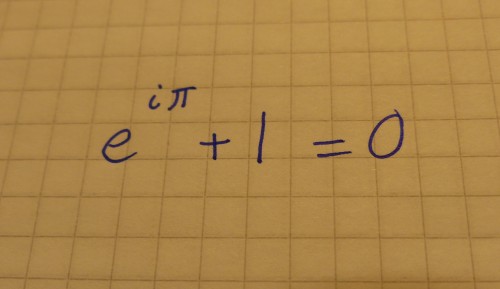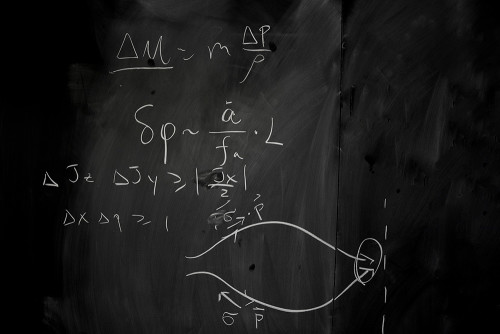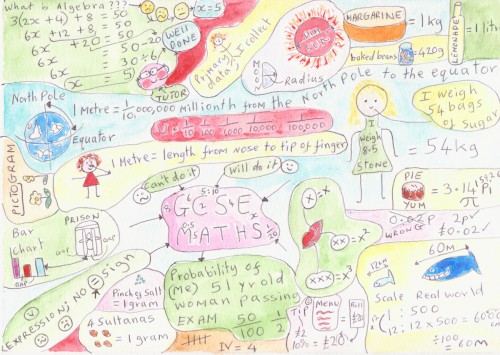Tag archives: mathematics
Spacesuit of the future, another ancient Pythagoras, Disney’s football analysis

The stuff of movies: new SpaceX suit could be in a film (Courtesy: SpaceX)
By Sarah Tesh and Michael Banks
Astronauts on board the SpaceX Dragon Capsule will look like they’ve stepped out of a sci-fi film. This week, Elon Musk revealed his company’s futuristic space attire on Instagram. The suits are aesthetically very different to the bulky gear NASA astronauts currently wear, the Extravehicular Mobility Unit (EMU). They are even sleeker than NASA’s next generation Z-2 suit, which was previewed in 2015. The SpaceX garb are apparently also easier to walk in and more practical for everyday use. While not quite at the tech standard of fiction, the SpaceX suits definitely look the part.
View all posts by this author | View this author's profile
Test your brains with the Physics World blackboard quiz
By Matin Durrani
Can you tell what branch of physics is being described on the blackboard above? It’s one of six photographs taken by the communications folks at the Perimeter Institute for Theoretical Physics in Waterloo, Canada, where blackboards are an integral feature of the building’s design, appearing everywhere from the lifts to coffee areas.
In this quiz, your task is to study six blackboards and match them up with the physics topics they represent. There’s no prize, other than the satisfaction of having at least some inkling of what those clever theorists at the Perimeter are up to.
So here are the six topics:
• Accretion physics and general relativity
• Cosmology
• Neural networks and condensed matter
• Particle physics 1
• Particle physics 2
• Strings
And here are the six blackboards (you can click on each to see it in more detail).
Frightening physics films, a furry physics doodle and an epic pub crawl
By Hamish Johnston
There are still 10 days to go until Halloween, but some physicists can’t resist getting into the spirit a bit early. Over at Symmetry, Kathryn Jepsen suggests a few scary physics films that would make for a spooky movie night on 31 October. They’re not actually real films, but rather a series of posters dreamt up at Chicago’s Sandbox Studio in collaboration with the illustrator Ana Kova. My favourite is Poltergauss (right), because trying to understand magnetism is terrifying.
View all posts by this author | View this author's profile
Michael Berry at 75

A moment to reflect – Michael Berry unveils a framed photograph of himself in the University of Bristol at an event to mark his 75th birthday. (Courtesy: Brian R Pollard)
By Matin Durrani
Anyone who gets invited to an event that’s being held on April Fools’ Day is bound to think there’s something fishy going on. But last Friday’s meeting to celebrate the 75th birthday of Bristol University physicist Michael Berry was a genuine commemoration of his career, although it did have its lighter moments.
Grandly entitled “Physics, Art, Mathematics, Science”, the meeting was intended to reflect Berry’s extensive and wide-ranging interests, which stretch from the physics of waves and quantum phenomena to optics, tidal bores and magnetic levitation. (There’s also a phenomenon called the Berry phase, although I understand Berry himself is reluctant to use that term.)
It’s difficult to summarize Berry’s many contributions to physics – he has written approaching 500 papers – so I’m going to take the easy way out and instead point you at his excellent website, where you can easily get lost down lots of entertaining and stimulating rabbit holes.
If there’s one item on his site I can recommend, it’s his description of how his work on the mathematics of magnetic levitation led him to share the 2000 IgNobel Prize for Physics with the future (genuine) Nobel laureate Andre Geim, who in 1997 levitated a frog using a powerful permanent electromagnet while at Bristol.
View all posts by this author | View this author's profile
Shorter queues for taxiing planes?

Spinning around: The air flow from the wing of a plane, made visible by using coloured smoke. (Courtesy: NASA)
By Ian Randall
If you’re as impatient as I am, the worst part about flying off for your summer vacation is the interminable hold-up that sometimes occurs right before take-off – waiting for the plane to taxi onto the runway and desperately hoping the in-flight entertainment will kick off soon. But these annoying delays may soon be cut down thanks to Georgios Vatistas and colleagues at Concordia University in Montreal. The team has developed a new mathematical airflow model to help refine the safe separation distances needed between planes during take-off and landing.
As an aeroplane moves along, the lift-generating difference in pressure between the top and bottom surfaces of its wings causes air to flow out from beneath each wing and up around the wing tip. This creates a circular vortex pattern behind each tip (pictured above), with a downwash in-between – forming a turbulent wake that can be hazardous to any craft that passes through it. If large enough, this turbulence can roll the next aircraft, faster than they can resist – leading to a crash.
View all posts by this author | View this author's profile
Molecular footballs, knotty headphones and a naming contest for exoplanets

Is this exoplanet more of a Joanne than a Derek? You could soon be casting your vote to name 305 explanets. (Courtesy: IAU/M Kornmesser/N Risinger)
By Hamish Johnston
With the final two matches of the FIFA World Cup to look forward to this weekend, I thought I would sneak one more football-related story into the Red Folder. Over on the arXiv blog, there is a nice commentary about the topological nature of World Cup balls through the ages. Why? Well, two chemists in Taiwan have worked out a way to create a carbon-based molecule with the same shape as the football currently being used in the tournament in Brazil. Called the Brazuca, the ball is made from six panels that each have a four-leafed clover shape. Together, they form a structure with octahedral symmetry.
View all posts by this author | View this author's profile
What makes an equation beautiful?
By James Dacey
Earlier this year I wrote about a psychology experiment that revealed that mathematicians appreciate beautiful equations in the same way that people experience great works of art. In the experiment, which conjures up a slightly comical scene, mathematicians were hooked up to a functional magnetic resonance imaging (fMRI) machine and asked to view a series of equations. When the subjects looked at equations they had previously rated as beautiful, it triggered activity in a part of the emotional brain associated with the experience of visual and musical beauty. The formula most commonly rated as beautiful in the study, in both the initial survey and the brain scan, was Euler’s equation, eiπ+ 1 = 0.
Inspired by this study, we have put together this infographic to dissect the Euler identity and try to understand why so many mathematicians are enamoured with this little equation. Let us know what you think of the infographic and what you think are the most beautiful equations. Either post a comment below this article, or let us know on Twitter using the hashtag #BeautifulEquations.
View all posts by this author | View this author's profile
Making brain-busting ideas easier to grasp
By Matin Durrani
With all the talk yesterday of evidence for inflation and signs of primoridal gravitational waves imprinted on the cosmic microwave background, many non-physicists (and probably quite a few physicists too) might have been left scratching their heads at the implications of the findings obtained by the BICEP2 experiment at the South Pole.
Unfortunately, there’s no getting away from the fact that many concepts in physics are hard and that cutting-edge experiments are incredible feats of technical endeavour. We can, though, all take solace from the fact that physicists at the frontiers of research have often spent decades living and breathing their subjects, which means they know the basics of their own field far better than anyone else.
Cruise-ship physics, the many ways to tie a tie, shaken-up carbon dating and more
By Tushna Commissariat
If you like piña coladas and quantum mechanics, then we hope you are currently on the two-week “Bright Horizons 19” Southeast Asia cruise, as on board is physicist and writer Sean Carroll. He will be giving multiple lectures over the next 15 days on everything from the Higgs boson to dark matter and other fundamentals of quantum mechanics. Also floating along with Carroll are other lecturers who will cover topics from natural history to genetics to military strategy. If, like us, you are stuck at home, you can take a look at Carroll’s slides on his blog, maybe have a cocktail while you are at it.
View all posts by this author | View this author's profile
Beauty is in the eye of the mathematician

Is the Euler identity the most beautiful equation of them all?
By James Dacey
If you have ever talked with your arty friends about the sense of “beauty” you feel from maths, you may well have been greeted with a sympathetic smile. Perhaps even with jeers of derision. Well, next time you find yourself in that position you will have some scientific evidence to back up what you are saying. A group of researchers in the UK has demonstrated that getting your noggin around an equation can trigger the same part of the brain as staring at the Mona Lisa or listening to The White Album.
In an experiment described in Frontiers in Human Neuroscience, 15 mathematicians were presented with a series of 60 equations and asked to rate them for their beauty on a scale of –5 (ugly), through to +5 (beautiful). The same subjects were then hooked up to a functional magnetic resonance imaging (fMRI) machine and asked to view the same list of equations. It turned out that when mathematicians viewed the equations they had previously rated as beautiful, it triggered activity in a part of the emotional brain associated with the experience of visual and musical beauty.*
View all posts by this author | View this author's profile


